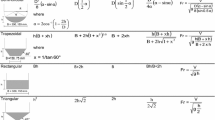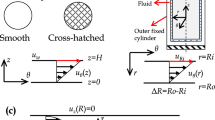Abstract
Non-Newtonian fluids are commonly seen in industrial processes, such as those of the oil and mining industry, and in natural flows, like dam ruptures, landslides or mud flows. The hydrodynamic modeling of such processes/phenomena is directly linked to the rheological properties of the flowing fluid, usually characterized through rheometers. The high cost of rheometers and possible inaccessibility for certain applications demand for research of alternative rheometric methods. In order to assess the problem, the present work discusses a detailed experimental methodology to evaluate if the steady and uniform flow in an inclined channel is able to produce the flow curve for the test fluid carbopol 996 gel and work as an alternative rheometer. In order to estimate the shear rates and shear stresses, we measured the normal depth (ultrasonic technique), specific discharge (manual gravimetric method) and free surface velocity (manually and with laser barrier sensors). Based on the theoretical solutions, a simplified fitting procedure was adopted to make possible the assessment of shear rate and shear stress through the experimental data. The obtained flow curves were then compared with the reference flow curve, determined by a commercial R/S rheometer. Results showed that the experimental methods were able to provide the flow curves within acceptable uncertainty and the defined methodology detailed in the work can estimate satisfactorily the flow curve of non-Newtonian fluids. Finally, we highlighted that the wide channel hypothesis is the strongest condition to be guaranteed in order to obtain precise flow curves through the methodology present in this work.














Similar content being viewed by others
References
Andersson HI, Shang DY (1998) An extended study of the hydrodynamics of gravity-driven film flow of power-law fluids. Fluid Dyn Res 22(6):345
Astarita G, Marrucci G, Palumbo G (1964) Non-newtonian gravity flow along inclined plane surfaces. Ind Eng Chem Fundam 3(4):333–339
Baudez JC, Chabot F, Coussot P (2002) Rheological interpretation of the slump test. Appl Rheol 12(3):133–141
Bird RB, Dai G, Yarusso BJ (1983) The rheology and flow of viscoplastic materials. Rev Chem Eng 1(1):1–70
Boger DV (2013) Rheology of slurries and environmental impacts in the mining industry. Ann Rev Chem Biomol Eng 4:239–257
Bonnoit C, Darnige T, Clement E, Lindner A (2010) Inclined plane rheometry of a dense granular suspension. J Rheol 54(1):65–79
Burger J, Haldenwang R, Alderman N (2010) Friction factor-reynolds number relationship for laminar flow of non-newtonian fluids in open channels of different cross-sectional shapes. Chem Eng Sci 65(11):3549–3556
Carrière S, Jongmans D, Chambon G, Bièvre G, Lanson B, Bertello L, Berti M, Jaboyedoff M, Malet JP, Chambers J (2018) Rheological properties of clayey soils originating from flow-like landslides. Landslides 15(8):1615–1630
Chambon G, Ghemmour A, Naaim M (2014) Experimental investigation of viscoplastic free-surface flows in a steady uniform regime. J Fluid Mech 754:332
Coleman B, Markovitz H, Noll W, Caswell B (1966) Viscometric flows of non-Newtonian fluids. Springer-Verlag, New York
Coussot P (1994) Steady, laminar, flow of concentrated mud suspensions in open channel. J Hydraul Res 32(4):535–559
Coussot P, Boyer S (1995) Determination of yield stress fluid behaviour from inclined plane test. Rheol Acta 34(6):534–543
Coussot P, Piau JM (1995) A large-scale field coaxial cylinder rheometer for the study of the rheology of natural coarse suspensions. J Rheol 39(1):105–124
Coussot P, Proust S, Ancey C (1996) Rheological interpretation of deposits of yield stress fluids. J Non-Newton Fluid Mech 66(1):55–70
Coussot P, Laigle D, Arattano M, Deganutti A, Marchi L (1998) Direct determination of rheological characteristics of debris flow. J Hydraul Eng 124(8):865–868
Coussot P, Nguyen QD, Huynh H, Bonn D (2002) Avalanche behavior in yield stress fluids. Phys Rev Lett 88(17):175501
De Larrard F, Ferraris C, Sedran T (1998) Fresh concrete: a herschel-bulkley material. Mater Struct 31(7):494–498
Durst F, Ray S, Ünsal B, Bayoumi O (2005) The development lengths of laminar pipe and channel flows. J Fluids Eng 127(6):1154–1160
Fiorot G, Maciel G, Cunha E, Kitano C (2015) Experimental setup for measuring roll waves on laminar open channel flows. Flow Meas Instrum 41:149–157
Fiorot GH, de Freitas Maciel G (2019) Free-surface laminar flow of a herschel-bulkley fluid over an inclined porous bed. J Non-Newton Fluid Mech 272:104164
Fiorot GH, Ferreira FdO, Dupont P, Maciel GdF (2018) Roll-waves mathematical model as a risk-assessment tool: Case study of acquabona catchment. J Hydraul Eng 144(12):05018009
de Freitas Maciel G, de Oliveira Ferreira F, Fiorot GH (2013) Control of instabilities in non-newtonian free surface fluid flows. J Braz Soc Mech Sci Eng 35(3):217–229
Gawu SK, Fourie A (2004) Assessment of the modified slump test as a measure of the yield stress of high-density thickened tailings. Can Geotech J 41(1):39–47
Ghemmour A, Chambon G, Naaim M (2008) Gravitary free surface flows used as a rheometrical tool: the case of viscoplastic fluids. In: AIP Conference Proceedings, American Institute of Physics 1027:1039–1041
Gutierrez L, Pawlik M (2015) Observations on the yielding behaviour of oil sand slurries under vane and slump tests. Can J Chem Eng 93(8):1392–1402
Haldenwang R, Slatter P, Chhabra R (2002) Laminar and transitional flow in open channels for non-newtonian fluids. In: Hydrotransport 15: 15th International Conference on the Hydraulic Transport of Solids in Pipes, BHR Group
Lavallée Y, Hess KU, Cordonnier B, Bruce Dingwell D (2007) Non-newtonian rheological law for highly crystalline dome lavas. Geology 35(9):843–846
Maciel GdF, Santos HKd, Ferreira FdO (2009) Rheological analysis of water clay compositions in order to investigate mudflows developing in canals. J Braz Soc Mech Sci Eng 31(1):64–74
Maciel GdF, Ferreira FdO, Cunha E, Fiorot G (2017) Experimental apparatus for roll-wave measurements and comparison with a 1d mathematical model. J Hydraul Eng 143(11):04017046
Minussi RB, Maciel GdF (2012) Numerical experimental comparison of dam break flows with non-newtonian fluids. J Braz Soc Mech Sci Eng 34(2):167–178
Mizani S, Simms P (2016) Method-dependent variation of yield stress in a thickened gold tailings explained using a structure based viscosity model. Miner Eng 98:40–48
Murata J (1984) Flow and deformation of fresh concrete. Mater Constr 17(2):117–129
Pashias N, Boger D, Summers J, Glenister D (1996) A fifty cent rheometer for yield stress measurement. J Rheol 40(6):1179–1189
Pellegrino AM, Schippa L (2018) A laboratory experience on the effect of grains concentration and coarse sediment on the rheology of natural debris-flows. Environ Earth Sci 77(22):749
Piau JM, Debiane K (2005) Consistometers rheometry of power-law viscous fluids. J Non-Newton Fluid Mech 127(2–3):213–224
Pierre A, Lanos C, Estellé P (2013) Extension of spread-slump formulae for yield stress evaluation. Appl Rheol 23(9):9. https://doi.org/10.3933/applrheol-23-63849
Poole R, Chhabra R (2010) Development length requirements for fully developed laminar pipe flow of yield stress fluids. J Fluids Eng 132(3):034501. https://doi.org/10.1115/1.4001079
Roussel N, Coussot P (2005) Fifty-cent rheometer for yield stress measurements: from slump to spreading flow. J Rheol 49(3):705–718
Scotto di Santolo A, Pellegrino AM, Evangelista A (2010) Experimental study on the rheological behaviour of debris flow. Natl Hazards Earth Syst Sci 10(12):2507–2514
Schatzmann M, Bezzola G, Minor HE, Windhab E, Fischer P (2009) Rheometry for large-particulated fluids: analysis of the ball measuring system and comparison to debris flow rheometry. Rheol Acta 48(7):715–733
Schowalter W, Christensen G (1998) Toward a rationalization of the slump test for fresh concrete: comparisons of calculations and experiments. J Rheol 42(4):865–870
Zhao C, Zhang M, Zhang T, Wang F, Gao J (2015) Response of roll wave to suspended load and hydraulics of overland flow on steep slope. Catena 133:394–402
Acknowledgements
The authors wish to acknowledge FAPESP for financial support under Process 2015/25518-8. Thanks are also given to CAPES for the first author scholarship (88882.433524/2019-01). Finally, the authors thank Doctor Fabiana de Oliveira Ferreira and Associate Professor Doctor Milton Dall’Aglio Sobrinho for their valuable collaboration.
Funding
This research was funded by São Paulo Research Foundation (FAPESP) under Process 2015/25518-8 and the Coordenação de Aperfeiçoamento de Pessoal de Nível Superior – Brasil (CAPES) for the first author scholarship (88882.433524/2019-01).
Author information
Authors and Affiliations
Corresponding author
Ethics declarations
Conflict of interest
The authors declare that they have no conflict of interest.
Additional information
Technical Editor: Edson José Soares.
Publisher's Note
Springer Nature remains neutral with regard to jurisdictional claims in published maps and institutional affiliations.
Appendix
Appendix
This Appendix shows the raw data obtained through the methodology described in Sect. 3, presenting measurements of normal depth h, specific discharge q, uncertainties related to specific discharge measurement \(u_q\), free surface velocity \(v_s\) and uncertainties related to free surface velocity measurement \(u_{v_s}\). The Reynolds number \({\rm Re}_H\), Froude number Fr and minimum Froude number \({\rm Fr}_{\rm min}\) are also calculated as indicated by Subsect. 3.3. The mean velocity \(\bar{V}\) for the automatized method was calculated through \(v_s\) measurement [20]. Tables 6, 7, 8, 9, 10, 11 present data corresponding to experimental tests made with channel slopes \(\theta\) of 4, 6, 10, 14, 16 and \(18^{\circ }\) using the Manual Gravimetric Method and the Manual Kinematic Method. Tables 12, 13, 14, 15, 16 presents data obtained through the automatized kinematic method with channel slopes \(\theta\) of 4, 6, 8, 16 and \(18^{\circ }\).
Rights and permissions
About this article
Cite this article
Sáo, Y.T., Pereira, J.B., Fiorot, G.H. et al. Obtaining flow curve for viscoplastic fluids through inclined open-channel apparatus. J Braz. Soc. Mech. Sci. Eng. 43, 278 (2021). https://doi.org/10.1007/s40430-021-02999-2
Received:
Accepted:
Published:
DOI: https://doi.org/10.1007/s40430-021-02999-2




